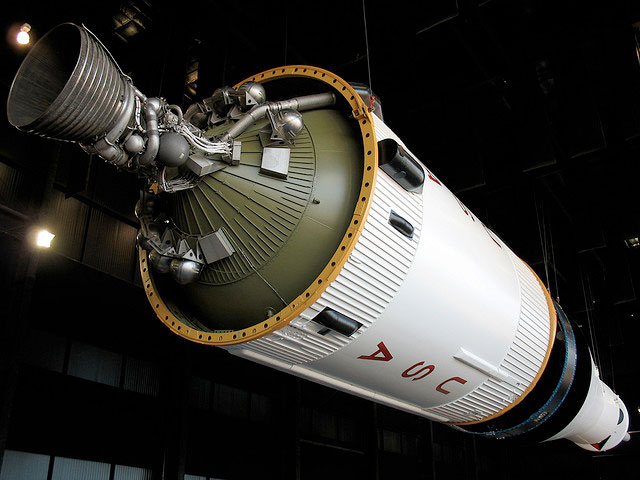Gunshots Damage Historic Saturn V Moon Rocket

A historic Saturn V rocket was damaged by gunfire Thursday (May 3), after someone shot three bullets into the Alabama museum where the mighty moon booster is on display.
The gunshots were fired just before 11:00 a.m. EDT (1500 GMT) outside the Davidson Center for Space Exploration at the U.S. Space & Rocket Center in Huntsville, Ala. The shots may have been fired from a moving vehicle traveling along Interstate 565, which runs parallel to the booster's window-fronted building, according to the Huntsville Police Department (HPD).
"Preliminary information indicates that there were three rounds fired, hitting 30 to 100 feet [9 to 30 meters] apart, which leads us to believe they were fired from a moving vehicle on the interstate," HPD communications director Harry Hobbs wrote in an e-mail to collectSPACE.com.
"The rounds were likely fired from a rifle, judging from the velocity needed to penetrate the glass," Hobbs said.
Although the museum was open to visitors at the time, no one was injured. The Davidson Center, which has housed the 363-foot (111-meter) Saturn V since 2007, was closed for about two hours following the shooting. [The World's Tallest Rockets: How They Stack Up]
In addition to displaying the Saturn V and other historical artifacts. the Space & Rocket Center is also home to the U.S. Space Camp and serves as the visitor center for NASA's Marshall Space Flight Center.
Bullets bounced off
Breaking space news, the latest updates on rocket launches, skywatching events and more!
The Saturn V at the Space & Rocket Center, which is one of only three such rockets remaining, was only bruised by the bullets.
"There was no puncture, the bullets did not enter," Edward Stewart, USSRC director of exhibits and curation, said in an interview with collectSPACE.com. "They hit it and bounced off."
Of the three bullets that were fired, the two that struck the rocket hit its third stage, referred to as the S-IVB.
"In one case, the impact that was towards the [stage's] aft end, there is a very, very slight indentation in the tank wall and of course, some loss of paint," Stewart said.
"The impact on the forward end is a deeper indentation. It is among the skirting that would interface with the [Saturn V's] instrument unit, where there are ridged stiffeners," he said. "It hit on the ridge of one of the stiffeners and dented it in pretty well. As it hit a straight metal surface, when it hit and dented, the vibration caused the paint to lift away."
The lifted paint led to the belief that the bullet had pierced the stage.
"It looks like a huge gaping hole, but what you're actually seeing is the shadow from the paint that peeled up," said Stewart.
The third bullet passed through the opening separating the rocket's first and second stages, missing five large engines in the process.
"It fortunately missed all the J-2s and impacted on the far wall of the building," Stewart said.
All three bullets struck areas that were well above visitors' heads, about 15 to 20 feet (4.5 to 6 meters) off the ground on the rocket and about 35 feet (11 meters) high on the far wall.
Smithsonian's Saturn V
The Smithsonian's National Air and Space Museum in Washington, D.C. owns the Saturn V, which is on loan to the Marshall Space Flight Center, which in turn has it on loan to the USSRC.
"We have seen media reports about a shooting incident involving the Saturn V rocket at the U.S. Space & Rocket Center and we are glad there were apparently no injuries," the Smithsonian said in a statement in response to collectSPACE.com. "We are waiting for officials there to provide information. It is premature to speculate on what actions might be required until we know details."
Stewart said that they plan to consult with Marshall Space Flight Center in regards to further engineering analysis of the damage. Detailed photos of the rocket were taken on Monday to provide to the NASA center.
It is not yet clear if the shooter may face federal charges, given the Smithsonian's involvement.
"NASA investigators are involved and assisting Huntsville Police Department investigators," Hobbs said.
The Saturn V at the U.S. Space & Rocket Center was first used for vibration studies at Marshall Space Flight Center in the 1960s in support of launching the massive booster to the moon. After decades being displayed outdoors, the rocket was restored and moved into the Davidson Center for Space Exploration in 2007.
Click through to collectSPACE.com to see a close-up photograph of the bullet damage to the historic Saturn V rocket.
Follow collectSPACE on Facebook and Twitter @collectSPACE and editor Robert Pearlman @robertpearlman. Copyright 2012 collectSPACE.com. All rights reserved.
Join our Space Forums to keep talking space on the latest missions, night sky and more! And if you have a news tip, correction or comment, let us know at: community@space.com.

Robert Pearlman is a space historian, journalist and the founder and editor of collectSPACE.com, a daily news publication and community devoted to space history with a particular focus on how and where space exploration intersects with pop culture. Pearlman is also a contributing writer for Space.com and co-author of "Space Stations: The Art, Science, and Reality of Working in Space” published by Smithsonian Books in 2018.
In 2009, he was inducted into the U.S. Space Camp Hall of Fame in Huntsville, Alabama. In 2021, he was honored by the American Astronautical Society with the Ordway Award for Sustained Excellence in Spaceflight History. In 2023, the National Space Club Florida Committee recognized Pearlman with the Kolcum News and Communications Award for excellence in telling the space story along the Space Coast and throughout the world.

